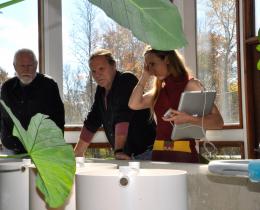Paul Hawken isn’t worried just about greenhouse gas emissions, despite their rising threat. He isn’t only railing about politics, despite the current administration’s dramatic reversal of decades of U.S. climate policy.
Hawken, the founder and former executive director of Project Drawdown, is worried about…words.
Verbs and adjectives, mostly.
“Science,” he said, “is extraordinary. Science communication is inept.”
His message is simple: How can we expect energetic support for climate change solutions when the news headlines are so disheartening and prevailing wisdom falls so short?
One news report, Hawken recalls, projected a 10-foot increase in sea levels with a doctored image of the Tower Bridge in London overwhelmed by frothy waves.
Hawken points out that while language and imagery can seem apocalyptic, solutions published in Scientific American and by the Union of Concerned Scientists seem to underestimate the severity of the situation and what’s needed to reverse it.
Among them: Be efficient. Consume less. Eat smart. Use power strips for home entertainment.
“These,” Hawken says, “are proverbs, not solutions.” When you hold those solutions up against the doomsday headlines, “anybody with an IQ of room temperature can see this is not adequate to the task at hand.”
That is why, Hawken says, the idea of mitigating climate change or reducing greenhouse gases falls short.
It is not enough to mollify the effects.
“If you are going over a cliff slowly, it’s just like Thelma & Louise,” Hawken says, referring to the slow-motion plunge taken by Susan Sarandon and Geena Davis in that film’s final scene. “It’s just not wise. And so the only goal that makes sense is not to reduce, but reverse.”
Enter Project Drawdown.
Imagine if you had a playbook with the 100 most substantive solutions modeled by dozens of scientists from 22 countries on six continents. Rhodes Scholars. Fulbright Scholars. White House Fellows.
Imagine if their work was reviewed by 128 advisors—geologists, engineers, climatologists, biologists, botanists, economists, financial analysts, and others.
Imagine if another 40 outside experts reviewed the mathematical models used to come up with the greenhouse-gas savings and financial impacts of the solutions.
Imagine if the major criticism of those solutions was that the estimation of their benefits was too conservative. (“Our scientific reviewers, almost to a person, criticized us for that,” Hawken said, “and we said, ‘Cool.’”)
What you are left with is what Hawken says is the most comprehensive plan ever proposed to draw down greenhouse gases and reverse global warming.
“We’ve done the math,” Hawken said.
What’s more, all of the technologies exist. And many of the solutions are being put into practice.
The problem: The frequency and scale of implementation needs to increase. Two hundred Drawdown contributors do not a world-saving movement make.
Everyone has a role they can play.
Hawken tells the story of Joe Dorgan, a Canadian farmer from Prince Edward Island. Dorgan wanted to save money on feed. So, he began walking his cows on the beach, where they dined on kelp washed ashore.
Dorgan discovered his cows produced more milk because kelp diets produce less methane.
That’s no small thing.
Methane is not only a sign of dietary inefficiency; it traps 34 times as much heat as carbon dioxide. Methane created in the digestive process from cows, sheep, goats, and similar animals accounts for as much as 4 percent of annual greenhouse gas emissions.
“On Prince Edward Island, every farm is on the beach,” Hawken says, “but not in the rest of the world.”
Building on the farmer’s experience, a team of scientists from Australia discovered that a species of red seaweed, when added as a supplement amounting to just 2 percent of feed, reduced methane production in cows by 99 percent.
“I want to communicate to people that humanity is on the case,” Hawken says. “We’re extraordinary. We’re genius. We’re imaginative. And we’re creating things that we never before have done.”
You may not be a farmer feeding your cows kelp. But everyone has interests, skills, experiences, and connections. Everyone can find ways to engage, learn, invest, facilitate, and be aware.
The first step, he says, is changing how we speak about climate change. War metaphors such as “battling climate change” don’t inspire meaningful action because they don’t bring people together.
“It doesn’t connect us,” Hawken says. The solution “is reimagining what it means to be a human being and the connection to others.”
PROJECT DRAWDOWN
Top 10 Solutions to Reverse Greenhouse Gas Emissions
1. Refrigerant management.
2. Wind turbines (onshore).
3. Reduced food waste.
4. Plant-rich diet.
5. Tropical forests.
6. Educating girls.
7. Family planning.
8. Solar farms.
9. Silvopasture.
10. Rooftop solar.
Want to learn more? Listen to Hawken on Omega's podcast, Dropping In.



